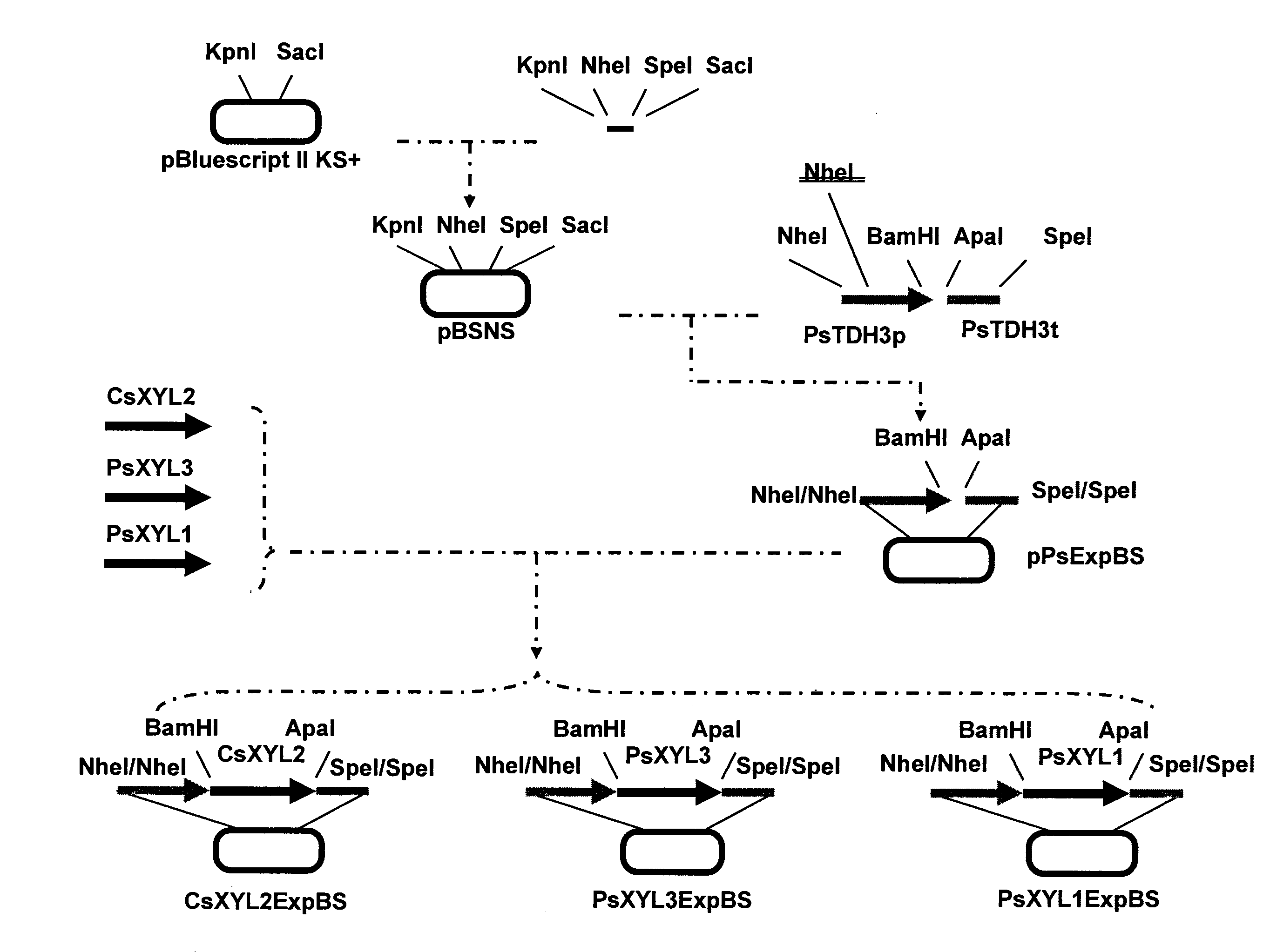DNA encoding xylitol dehydrogenase
a technology of xylitol dehydrogenase and dna encoding, which is applied in the field of dna encoding a polypeptide, can solve the problems of xylose isomerase genes, xylose fermentation, and failure to isolate and achieve the effect of isolating xylitol dehydrogenase genes from i
- Summary
- Abstract
- Description
- Claims
- Application Information
AI Technical Summary
Benefits of technology
Problems solved by technology
Method used
Image
Examples
example 1
Isolation and Sequencing of Xylitol Dehydrogenase Gene from Candida shehatae Isolation of Chromosomal DNA
[0088]Candida shehatae NBRC1983 (CBS5813) was purchased from Department of Biotechnology, National Institute of Technology and Evaluation. Saccharomyces cerevisiae ATCC60715 was purchased from American Type Culture Collection. These yeasts were separately grown by shaking culture in YPD medium (2% peptone, 1% yeast extracts, and 2% glucose) at 25° C. until a resting stage. Chromosomal DNAs were isolated therefrom using Dr. GenTLE (Takara Bio Inc., Otsu-shi, Shiga, Japan) according to the protocol included therein.
Determination of Nucleotide Sequence of Candida shehatae Xylitol Dehydrogenase Gene
[0089]The DNA sequences of Pichia stipitis and Candida tropicalis xylitol dehydrogenases (accession Nos. DD278642 and DQ201637, respectively) were obtained from a nucleic acid sequence database GenBank and subjected to sequence comparison using gene analysis software Genetyx (Genetyx Corp....
example 2
Construction of Xylitol Dehydrogenase Expression Vector and Introduction Thereof into Yeast
[0094]A xylitol dehydrogenase expression vector was constructed according to procedures shown in FIG. 1. Hereinafter, the construction will be described in detail. In this context, the PCR conditions described below are as follows: 94° C. for 1 minute, (94° C. for 30 seconds, 55° C. for 30 seconds, and 72° C. for 3 minutes)×35 cycles, and 72° C. for 7 minutes.
[0095]pBluescript II KS+ (Stratagene) was digested with KpnI and SacI, and the shorter fragment was removed using Chroma Spin TE100 (Invitrogen Corp.). On the other hand, the oligo DNAs of SEQ ID NOs: 7 and 8 were denatured by heating at 95° C. for 5 minutes and then left at room temperature for spontaneous annealing. This annealing product was cloned into the KpnI-SacI site in the pBluescript II KS+ to construct a vector pBSNS comprising NheI and SpeI sites inserted in between the KpnI and SacI sites of the pBluescript II KS+.
[0096]Prime...
example 3
Measurement of Xylitol Dehydrogenase Activity
[0106]The obtained Saccharomyces cerevisiae transformants were subjected to xylitol dehydrogenase activity measurement as shown below.
[0107]For preculture, the strains were inoculated into 2 mL of SD-ura (2% glucose) per test tube and shaking-cultured at 25° C. for 24 hours. 200 μL of the preculture solution containing the strains was inoculated into 5 mL of SD-ura (2% glucose) per test tube and main-cultured at 120 rpm at 25° C. for 24 hours. After the culture, the yeasts were collected by centrifugation, washed with a 100 mM sodium phosphate buffer solution (pH 7.0), 1 mM EDTA, and 5 mM mercaptoethanol, and then resuspended in 1 mL of the same buffer solution. To this yeast suspension, 1 g of GLASS BEADS 212-300 microns (SIGMA) was added, and the yeasts were disrupted at 4° C. for 15 minutes using MIX-TOWER A14 (TAIYO). After centrifugation at 120 rpm at 4° C. for 5 minutes, the supernatant was collected and used as a crude enzyme solut...
PUM
| Property | Measurement | Unit |
|---|---|---|
| Fraction | aaaaa | aaaaa |
Abstract
Description
Claims
Application Information
 Login to View More
Login to View More - R&D
- Intellectual Property
- Life Sciences
- Materials
- Tech Scout
- Unparalleled Data Quality
- Higher Quality Content
- 60% Fewer Hallucinations
Browse by: Latest US Patents, China's latest patents, Technical Efficacy Thesaurus, Application Domain, Technology Topic, Popular Technical Reports.
© 2025 PatSnap. All rights reserved.Legal|Privacy policy|Modern Slavery Act Transparency Statement|Sitemap|About US| Contact US: help@patsnap.com



